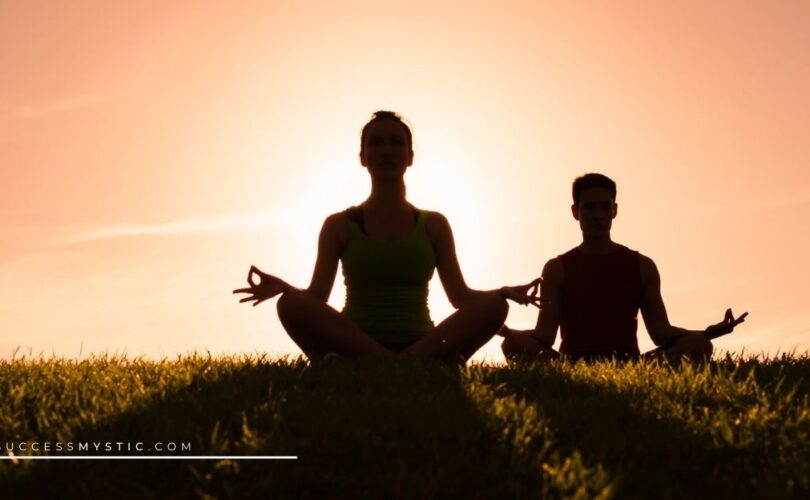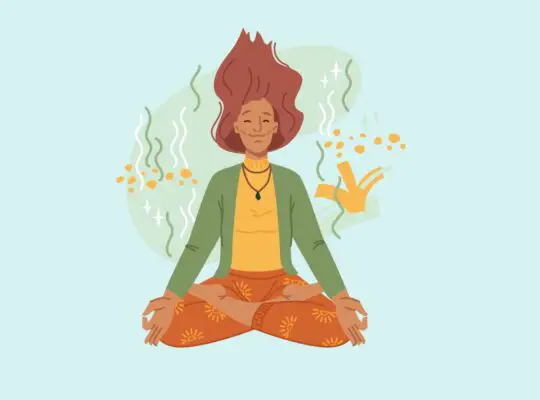To some, the idea of meditation seems like little more than “that whoo-whoo hippie crap.”
And for many, meditation has become a part of daily life and practice.
Meditation, as a practice of turning your focus and attention inward to a single point of reference within, is a powerful tool in your self-development arsenal. Among the many benefits of meditation, one of them is developing a language and medium of communication between your consciously aware self and your inner self.
That’s right.
That inner you who you fight with all the time. That voice that always sounds off with criticism when you really need your self-confidence the most. The inner you who you feel lonely with.
We talk about creating and developing a better intrapersonal relationship, and about self-development because these things are important to all of us. But, the one tool that we have at our disposal that often gets pushed aside for seemingly more pressing matters is the time taken to stop and meditate
The best part of this is that daily practice of meditation needs only 5 minutes, requires no special equipment or tools, and it’s a learning process so expertise is not required to start.
However, to like anything, to start you still need some basics.
- Arena’s
- Types
- Schools
3 Arenas of Meditation
- Spiritual
- Mental
- Physical
Spiritual meditation is meditation focused on and guided by some sort of divine purpose. Christians often use this type of meditation when they sit in contemplative silence or sit in the presence of their God. Many Buddhist meditations like Zazen have a spiritual component.
Mental Meditation is a form of meditation which focuses on a value system or psychological need. Mantra and Affirmation Meditations are examples of these. In Affirmation Meditation, the practitioner will repeat a meaningful phrase for the purpose of convincing their inner self of the truth of it.
I can quit smoking. I am strong enough. I will not be beaten down by addiction. I can live without my abuser. I am not afraid of snakes. My family love me. There is no reason to fear bungee jumping. Etc.…
The most widely publicized form of Physical Meditation is Yoga. There are literally hundreds of different yogic practices and schools, so there’s something for everybody and situation. Tai Chi is also a popular alternative for yoga, originating from China while yoga originated in ancient India.
Although physical meditations often have other benefits, their methods of use allow the practitioners to look inward for the strength to hold the poses or move along a given flow.
There are several different types of meditation within those arena’s…
- Body Scan Meditation – or Progressive Relaxation
- Breathe Awareness Meditation
- Transcendental Meditation
- Mantra Meditation
- Self-Enquiry
- Yogic Meditations
- Taoist Meditations
- Guided Meditations
- Christian Meditations
- Buddhist Meditations
- Beginners Meditations
- Spiritual and Non-Spiritual Meditations
The point of all of these widely generalized schools of meditation boil down to meditation for the goal of encouraging a physiological or psychological awareness and link between that awareness and your conscious mind.
Forms of Buddhist Meditation
- Zazen
- Vipassana Meditation
- Mindfulness Meditation
- And Metta Meditation
The methods and techniques involved in Vipassana Meditation helps the practitioner to ground her body and understand the processes of her mind. The goal of Metta Meditation (or Loving Kindness) is to help the practitioner to cultivate an attitude of love and kindness which goes deeper than the surface. The idea here is that the practitioner can hone and develop true feelings of love and kindness for every being and concept including enemies and stressors.
The Hindu School
- Transcendental Meditation
- Yoga Meditations
- And Self- Enquiry
Yoga
Interestingly, Yoga Meditations is a school within itself. There are numerous different forms of yoga.
- Third eye
- Chakra
- Trataka
- Kundalini
- Kriya
- Nada Yoga
- Tantra
- Pranayama
During yoga, the practitioner will physically move her body into various positions and poses as each one delivers something different for purpose.
Christian Meditation
- Contemplative
- Prayer
- and Reading
Though it’s less often the case where practitioners provide concerted effort to Meditate in the way practitioners will during Mantra, Kundalini, Progressive relaxation, or Zen meditation, these are powerful forms of meditation none the less.
Mantra Meditations
These are your Om meditations. With this form of meditation, the practitioner repeats a mantra, verbally or mentally. The mantra isn’t meant to have a specific meaning, and it’s not meant to be anything like an affirmation which the practitioner might use to convince herself of something.
Rather, the choice of the word, and how it’s pronounced is focused on because of the vibration associated with the sound. The mantra can be chosen by the practitioner or a teacher, but its primary purpose is to be the thing which the practitioner will focus on during his meditative practices.
Mantra meditations exist within Taoist, Buddhists, and Hindu traditions along with Jainism, and Sikhism.
The point here is that there are literally hundreds of variations of meditations. Each one has a unique method, purpose, and goal. Focusing on specific goals is meant to yield specific results, but there is a form of meditation for every conceivable need in your journey to create a better you.
Basic Beginners Meditation
If you’re new to meditation, or even if you’re as familiar with it as you are your dysfunctional habits, the sheer number of forms of meditation, schools, and practitioners’ opinions can be daunting. The best place to start is at the beginning, with some basics, and let your intuition guide you from there.
- Get comfortable
- Close your eyes
- Breathe
- Pay attention
- Return
- Time
The first thing you want to do is get comfortable. This isn’t a TV show. It’s not about looking good. What you’re about to do is about being comfortable in your mind and in your body. We’re working on the psychological aspect of that, so let’s start with a physical aspect first.
You can sit cross legged on the floor with your wrists on your knees and palms facing up if you like. You can also sit on your couch. Lie in your bed. Stand in your shower. Sit at your desk at work.
However, and wherever you feel comfortable, and will have three minutes of peace will suite you well. Find that geological location, and your comfort spot to start. Close your eyes and breathe.
You’re not going to regulate your breathing. Instead, you’re going to pay attention to your breathe. At some point or other, your mind will wonder. This is okay. The point here isn’t to shackle your mind or thoughts to one concept.
That would be impossible.
Your mind, like many, is ground zero for an internal tornado zone. It’s a disaster, and the more you try to control where your thoughts go the more, you’re going to lose grip on what little control you have. Instead, gently remind yourself to return to focusing on your breathing.
Despite common misconceptions to the contrary the point of meditation is not to empty your mind of thought. It’s to find what your thought is. In some cases, the meditation goes further to change the course of those thoughts or get to know them a little better. There isn’t any kind of meditation which focuses on judging those thoughts or yourself. Some forms of meditation, like Metta, do focus on finding love and joy rather than anger and frustration, but there should be no internal judgement.
When you find your thoughts wondering, simply return to your breathe. That’s the whole point of this exercise. In fact, that’s the beneficial part of most meditations. The point in this process where you catch your mind wondering and you gently remind yourself to return to your breathe. That’s the point where your mind achieves the goal of this exercise, where it gets the most initial benefit from the beginning process.
Finally, limit your time to 2 to 5 minutes initially. This isn’t like going to the gym or getting through leg day. There’s no need for reps and sets, or long periods of physical activity to keep a certain pace.
You literally only need to do this for a short time every day. In fact, once you sit, breath, lose your train of thought, and return to your breath, you’re really done for now. Once you return to your breath, you’ve achieved the primary goal of beginning meditation.
If you’d like to continue to grow this experience until you find that perfect meditation school and practice for you, you can set a timer for up to 5 minutes. Try going longer and longer without losing track of your breathe. Or look to shorten the time between when your mind begins to wonder, and when you return to your breathe. Either one will be perfect.
Three Pillars Of Meditation
There are basically three pillars of meditation. (ref.)
- Habit
- Technique
- Application
We’ve already talked about the types of techniques, but why is that so important?
If the list above tells you anything, it should tell you that there isn’t going to be any one specific technique that’s right for you, everybody, and their granddaughter in every single situation. It’s like nutrition. We all need different things at different times.
Yoga, in any of its various forms, isn’t right for everyone. In fact, some people loathe the idea of any type of yoga. That’s okay. There are individuals who aren’t going to do well with Mantra or Affirmation Meditation because maybe the sound of their voice is distracting to them. That’s fine.
But there are schools and techniques that are right for you. Even when you do find a meditation that’s right for you, it’s not going to be a one size fits all for all of your moods or energy levels.
So, what do you do?
Find a technique that works for you in that situation and mood. When your mood changes your intuition will tell you that a bit of Mantra today just isn’t going to do you any good. So, find another type of meditation that fits your moods. Maybe your body wants to move more while you focus on your breathing. Yoga isn’t the only physically active form of meditation.
Also, bear in mind that different meditation techniques will have an effect on different aspects of either your life or personal self. Some will improve your mood or outlook while others will allow you to gain more focus for work related activities. In addition to what suits you personally, this will have an effect on what types of meditation you choose for you.
Application
Meditation provides a number of benefits. Even a short amount of practice can begin to alter the way you see the world or interact with the people around you. It can change your perspectives in the short term.
However, the benefits you yield from meditation can simply be incidental consequences or purpose driven results. The result will depend heavily upon your application of meditative practices.
Meditation shouldn’t become something on your to-do list that you do mechanically just to tick it off. It could, but then you wouldn’t derive any joy from it. Driving purpose into your meditation will allow you to guide the changes you make and the other benefits you reap.
It’s like gardening in this respect. You can go out, plant a bunch of seeds and see what you do or don’t get. But, if you do this, the joy will be short lived. Eventually, pests will eat away what does manage to grow, and without care, weeds will drown the rest out. If anything does manage to yield fruit, there’s really no telling what you’ll actually get, or if you’ll like what you get.
However, if you go out, plan the lay out of the garden to benefit best from the direction of the sun, location of any shade giving trees and, avoid laying beds where they might get washed away from the rain you have a good start.
If you plan out what seeds go where, tend to the garden daily by pulling out weeds, introduce predatory insects like lady bugs to minimize pests, band the cabbage heads, stake the tomatoes, provide a fence or trellis for the cucumbers, and feed the garden you may actually have a buffet come fall.
Gardening with purpose and just laying random seeds will both yield short-term, short-lived, minimal results. However, only gardening with purpose will actually yield a crop that can extend into the winter months. Meditation is the same. Also, like gardening, meditation is a daily, year-round activity.
For those of us who love meditating and gardening, neither are a chore and both are highly enjoyable, highly beneficial, activities when they are applied with purpose.
The Importance Habit
Meditation is a lot like physical exercise in that it needs to be integrated as a routine. The many benefits we yield from meditation include reducing stress, increasing focus, learning to live in the moment, enhancing your attention span or cognitive performance, etc.
These benefits are like muscles you use and flex every day. However, like muscles, if you don’t use them, build them, and shape them eventually the world will start to eat them away. Every single day you’re exposed to stressors like your sister screeching at you for any given random reasons, your boss telling you that your ideas are stupid, or your kid cussing at you because you won’t buy him that candy bar. All of these occurrences claw and scrape at our patience, self-esteem, confidence, and emotions. With enough wear we become afraid, or not confident enough, to rely upon our intuition or give in to our creativity. We forget why we want to feel love and show kindness.
So, like any muscle group, your whole inner being needs 2 to 5 minutes every single day to build up your intrapersonal, psychological, and physiological resilience against the beat down pounding on your metaphoric door every day.
The benefits of purpose driven meditation can be long lasting. However, if you go long enough without re-energizing or working to build this muscle group, eventually you’ll expend the fuel of these benefits and run out.
Benefits Of Meditation
For all of the different types, schools, and arenas of meditation, when done correctly and purposefully, there are more benefits than should be listed here. But this is a cursory look at the way meditation can benefit you in your search for a better self, or in your self-development journey.
- It helps you to build the skills you need to manage things like stress and stressors
- You will find appropriately functional ways to deal with adversity like criticism, failure, or personal and financial loss
- Some forms of meditation center on helping you to focus on the present rather than dwelling on the past or stressing out over the future
- It increases concentration
- Mediation can help you fight certain illness like anxiety, addiction, and depression
- It can enhance your attention span and allow you to create a center of focus on your work. This is especially helpful for people who struggle with something like ADD.
- Meditation creates a habit of introspection.
- It cultivates a growth mindset which helps the practice of meditation become a self-feeding ever evolving cycle of self-improvement
- It enhances your cognitive performance and cortical structure
- Your prosocial behaviors and tendencies become more beneficial to the environment around you.
- People who meditate are more likely to show compassion in times of need.
- Mediation which involves some spiritual or moral aspect will impact your ego’s investment in that belief
- It can help to strengthen your immunity
- Inward reflection creates an ability for you to see yourself as you really are. Not just how your ego wants to be seen. This can have a major impact on your interpersonal relationships and your significant other matrix.
- It will help you better develop a healthy intrapersonal relationship and understand yourself.
- Physically active forms of meditation have a healthful impact on the body, and its ability to move, bend, and stretch.
You
It was an Austrian Neurologist who gave us psychoanalysis, and his theory of the Id, the Ego, and the Superego. You’ve probably heard of him: Sigmund Freud.
As is the fate of the work of all great minds and scientists, most of his theories have been disproven. This was bound to happen as his theories were just that- not proven fact. It happens. One of his theories to survive most scrutiny thus far, however, is his model of the psyche.
The id is said to be our most primal desires and needs. This is what drives us to eat, sleep, and do other primal things. The ego is our conscious self. It’s the ego that negotiates with the id on a subconscious level and obtains the things which the id desires. The Superego is your moral structure. This informs your value system and behavior models.
Let’s talk about the ego for a moment.
We hear the phrases all the time.
Your ego is in your way.
He’s so egotistical…
With comments and viewpoints like this it’s easy to believe that your ego is a bad thing, but it’s not. It’s your survival mechanism. It’s the part of your psyche that keeps your id from taking over in heated situations. Your ego is responsible for ensuring your security and survival.
In Maslow’s hierarchy of needs, we first seek shelter and food. After that need has been substantially met, we look for comfort and companionship. Basically, your id has to be fed first, then your ego can take over and look for ways of supplying your higher needs like socializing and self-actualization.
Your ego is like your intrapersonal currency. You invest it on a set of beliefs which you then protect. These beliefs will stem from your personal experiences, but essentially your ego is informed by your emotions because your emotions are reactive to what you choose to pay attention to.
So, for whatever reason, you’re looking to make a better you through meditation. Freud’s model of the human psyche helps to explain why meditation has been such a benefit to so many people in so many situations. While your ego negotiates your id’s responses to outside stimuli, your superego informs your ego and id by providing moral and religious boundaries.
However, in situations where our egos are highly invested in a belief, we tend to protect that belief structure at all costs- even if it’s dysfunctional and harmful. This is where our dysfunctions come out to play.
Examples of this include:
- Becoming short tempered with a co-worker you don’t like
- Getting upset over feedback rather than listening to the critique and making needed changes
- Telling yourself that someone is just jealous when she insults your hair
- Getting mad at a friend who suggests a larger jean size in earnest
- Yelling at your husband when he doesn’t like your cooking
We hold onto belief systems which define our individual personalities. A woman who believes she’s better in the kitchen than Gordon Ramsey has likely invested a large amount of her ego into this belief. So, when her children or spouse repeatedly don’t like the foods she prepares, she may expend a large amount of energy dissociating from the truth rather than face it: She’s actually horrible at cooking.
What does this have to do with meditating for a better you?
Well, it’s simple. Rather than showing yourself some self-compassion, many of us tend to revert to defense mechanisms and dysfunctional behaviors. Meditating shines a light on your ego and it’s hard to ignore.
If you want to become a better, you then this is the place to start. We all do some version of this whether it involves our professional talent, a hobby, raising children, sports participation, etc.… We all do this in some way. Another area where our ego gets in the way is our social behaviors.
Did you know that more than 65% of Americans actually believe they have above average intelligence? (ref.)
If 65% of us are smarter than the average Jane or Joe, the 35% of us must really be lacking in intelligence somewhere because, as you know, an average is derived by adding all numbers in a given set and dividing that sum by the total number of participating factors.
Given that fact, it’s easy to see why many of us will drive past someone begging on a street corner or at an intersection. We often glaze over the needs of the less fortunate, or mock men and women who are on the heftier side of body size.
Schools are telling parents their children are obese based strictly on weight even though muscle weighs more than fact. Young women in school are being forced to adhere Band-Aids where they ought not be applied because their bodies are distracting to young men.
Why is this important?
Look at the long list of benefits derived from meditation. One of those benefit’s is an improvement in the way we see ourselves, the world around us, how we fit into that world, how we interact within our environment, our prosocial behaviors when it comes to willingness to help someone in need, and our willingness to stand up for injustices when we see them in action. (ref.)
Someone who has spent time taking part in guided mindful meditation is going to be more willing to give a sandwich to the Vietnam Veteran who suffers from PTSD so bad that he can’t hold a job or spend a night inside a building. Someone who has spent time in wrapped in the warm bubble of self-reflection is more likely to understand why assaulting a young woman, and then blaming her body shape on the distraction of teenage boys is not okay.
Spending time meditating in some way is very likely to give you an introspective view of how your ego is invested in certain beliefs, and if that investment was properly made to begin with. Inward reflection allows you to connect your superego, id, and ego in such a way as to allow your conscious self to spend time with your inner self to develop that intrapersonal relationship. Remember that there is a difference between being alone and being lonely. Many people can’t be alone with their selves, and internal thoughts without feeling lonely. Many others have the psychological resilience to take a train ride from Tampa to New York alone for the fun of it.
Meditation involves internal reflection and visitation. The more time you spend with yourself, the more you get to know and understand yourself. Also note that we’re all born with a need to improve. There are two ways this goes.
One way is the view that because there is room for improvement, then there must be something wrong which needs to be fixed.
The more functional thought is that we are always growing until we’re not. There is no end point in self-development. It’s a journey and like on any trip the destination really isn’t the point; the journey is. Meditation is one tool we use along the way so that we can constantly level up. This doesn’t mean that there is something wrong with you that needs to be fixed. It only means, that you’re still growing. Meditation gives you the internal view of yourself so that you can see where you’re stunting your growth, and where you’re succeeding the most. (ref.)







